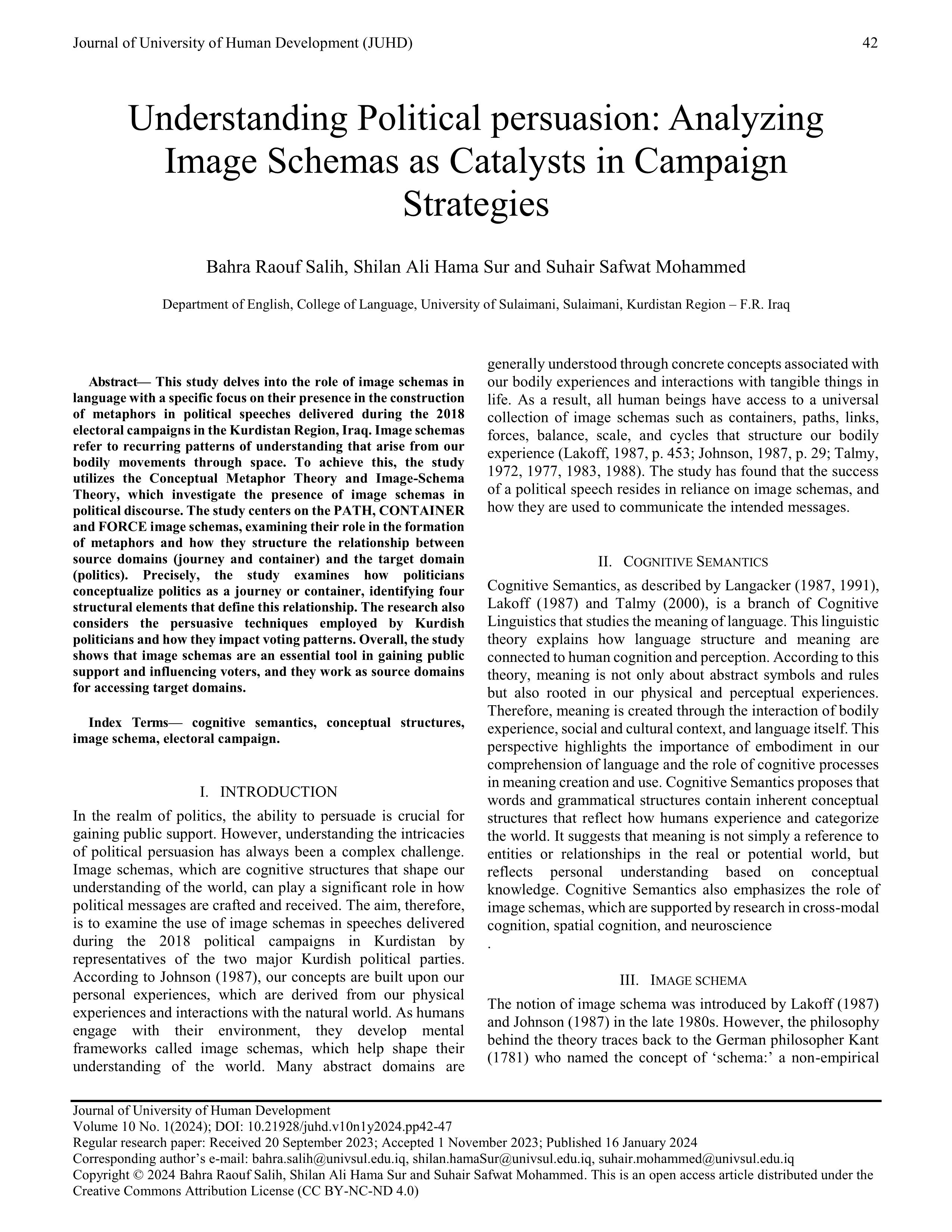Understanding Political persuasion: Analyzing Image Schemas as Catalysts in Campaign Strategies
DOI:
https://doi.org/10.21928/juhd.v10n1y2024.pp42-47Keywords:
Cognitive semantics, Conceptual structures, Image schema, Electoral campaignAbstract
This study delves into the role of image schemas in language with a specific focus on their presence in the construction of metaphors in political speeches delivered during the 2018 electoral campaigns in the Kurdistan Region, Iraq. Image schemas refer to recurring patterns of understanding that arise from our bodily movements through space. To achieve this, the study utilizes the Conceptual Metaphor Theory and Image-Schema Theory, which investigate the presence of image schemas in political discourse. The study centers on the PATH, CONTAINER and FORCE image schemas, examining their role in the formation of metaphors and how they structure the relationship between source domains (journey and container) and the target domain (politics). Precisely, the study examines how politicians conceptualize politics as a journey or container, identifying four structural elements that define this relationship. The research also considers the persuasive techniques employed by Kurdish politicians and how they impact voting patterns. Overall, the study shows that image schemas are an essential tool in gaining public support and influencing voters, and they work as source domains for accessing target domains.
References
Evan, V. (2007) A Glossary of Cognitive Linguistics. Edinburgh: Edinburgh University Press
Hamawand, Z. (2016) Semantics: A cognitive account of linguistic meaning. Sheffield: Equinox Hampl, K. (2021) The
container and force schemas in political discourse. University of Žilina.
https://www.facebook.com/qubadtalabaniofficial/
Hurtienne and Blessing (2007) Design for intuitive use - Testing image schema theory for user interface design.
Hurtienne et al. (2015) Designing with Image Schemas: Resolving the Tension Between Innovation, Inclusion and Intuitive Use. Oxford: Oxford University Press
Johnson, M. (1987). The body in the mind: The bodily basis of meaning, imagination and reason. Chicago: University of Chicago Press.
Krzeszowski, T. P. (1993). The axiological parameter in preconceptual image schemata. In R. Geiger & B. Rudzka-Ostyn (Eds.), Conceptualizations and mental processing in language (pp. 307–329). Berlin: Mouton de Gruyter. https://doi.org/10.1515/9783110857108.307
Kant, I. (1781). Immanuel Kant’s Critique of Pure Reason (Norman Kemp Smith, Trans.). New York: St. Martin’s Press (Macmillan), 1929.
Lakoff, G., & Johnson, M. (1980). Metaphors we live by. Chicago: University of Chicago press.
Lakoff, G. (1987). Women, fire and dangerous things: What categories reveal about the mind. Chicago: Chicago University Press. https://doi.org/10.7208/chicago/9780226471013.001.0001
Lakoff, G. (1999) Metaphorical Thought in Foreign Policy Why Strategic Framing Matters. The University of California at Berkeley and The Rockridge Institute.
Langacker, R. W. (1987). Foundations of cognitive grammar: Theoretical prerequisites (Volume I). Stanford: Stanford University Press.
Langacker, R. W. (1991). Foundations of Cognitive Grammar, Vol. 2: Descriptive Application. Stanford: Stanford University Press.
Mandler, J. M. (2004). The foundations of mind: Origins of conceptual thought. New York: Oxford University Press. https://doi.org/10.1111/j.1467-7687.2004.00369.x
Peña, S. (1998). Conceptual Projection and Image Schemas. EPOS, XIV, 451-461
Peña, S. (1999). Subsidiary relationships between image-schemas: An approach to the force schema. Journal of English Studies, 1, 187-207.
Sweetser, Eve E. (1982) Root and epistemic modals: causality in two worlds. In: Proceedings of the Eighth Annual Meeting of the Berkeley Linguistics Society (1982). Berkley, C.A.: Berkley Linguistics Society, 484–507
Talmy, L. (1977) Rubber-sheet cognition in language. In Papers from the Thirteenth Regional Meeting,Chicago Linguistic Society (pp. 612-628). Chicago: University of Chicago Press.
Talmy, L. (1983) How language structures space. In Jr., Pick, L. Herbert, & P. L. Acredola (Eds.), Spatial orientation: Theory, research, and application (pp. 225-282). New York: Plenum Press. https://doi.org/10.1007/978-1-4615-9325-6_11
Talmy, L. (1988). Force dynamics in language and cognition. Cognitive Science, 12, 49-100.
https://doi.org/10.1207/s15516709cog1201_2
Talmy, L. (2000) Toward a cognitive semantics. Cambridge (MA).

Downloads
Published
How to Cite
Issue
Section
License
Copyright (c) 2024 Bahra Raouf Salih, Shilan Ali Hama Sur , Suhair Safwat Mohammed

This work is licensed under a Creative Commons Attribution-NonCommercial-NoDerivatives 4.0 International License.


